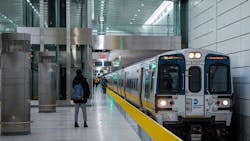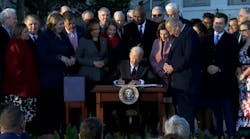The Federal Transit Administration (FTA) has awarded $9.9 billion in federal funding to support public transportation. The $9.9 billion is the largest round of funding made available for transit.
The partial-year Fiscal Year (FY) 2024 funding is detailed in apportionment tables that specify funding to states, urbanized areas and Tribal governments based on statutory formulas.
FTA notes full-year formula funding will be available once Congress passes an FY 2024 appropriations bill. Once enacted, transit funding will support the Infrastructure Investment and Jobs Act to support transit in 500 urban communities across the country and rural transit systems nationwide, allowing hundreds of transit agencies to buy new buses and railcars, improving reliability and transit service.
“When we invest in public transit, we improve daily life for millions of Americans across the country and make it easier, safer and more affordable to get around communities of every size,” said U.S. Department of Transportation Secretary Pete Buttigieg. “The Biden-Harris administration is making the largest investment in public transit in U.S. history, including $9.9 billion announced today, to help communities improve public transit and expand it to reach more people than ever before.”
The publication of apportionment tables specifies funding available through FTA formula programs and represents a partial year of federal support for transit. The tables allow transit providers nationwide to move forward with applications for FY 2024 funds to support expanding and modernizing transit systems and operations. The funding reflects formula funding available for five months (Oct. 1, 2023, to March 1, 2024) at FY 2023 levels while the federal government operates under a Continuing Resolution.
“The Bipartisan Infrastructure Law provides significant increases to transit funds across the country, from counties with just one van providing rides to systems operating hundreds of trains, buses and ferries in the largest cities in America,” said FTA Acting Administrator Veronica Vanterpool. “Communities depend on this funding to start new projects, fix old infrastructure and bring more fast, safe, convenient service.”
FTA distributes formula funds to state Departments of Transportation, Tribal nations and urbanized areas. Formula-based grant programs include funding for transit systems in both urbanized and rural areas, grants for buses and bus facilities – including low- and no-emission buses – transit designed for seniors and people with disabilities, planning funds and support to improve the condition of transit assets. The publication of apportionment tables allows transit agencies and grant recipients to view the amounts for programs set by statutorily defined formulas so they can better plan and manage over the long term for new projects and address their repair backlogs.
This year, due to changes resulting from the 2020 Census, FTA says some areas will see changes to funding amounts due to new urbanized area boundaries, as well as changes in populations. The apportionments reflect changes occurring in areas that exceed or fall below the 50,000 population threshold for urban areas, as well as other thresholds within the urban programs that determine whether funds are apportioned to the states or directly to urbanized areas.



